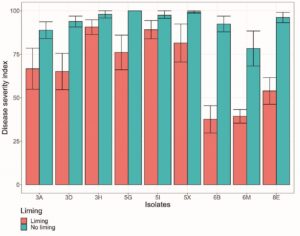Are there pH-insensitive strains of clubroot?
Stephen Strelkov, researcher at the University of Alberta, recently investigated a very specific (currently unknown) factor affecting the efficacy of liming treatments on the pathogen that causes clubroot in canola.
The practice of adding lime to increase the pH of soil has been used to manage clubroot in cruciferous vegetables, but liming requires considerable effort and expense when used in a canola production system. Check for consistent successful results before considering full adoption. For instance, while infection and clubroot disease symptoms are favoured by acidic soils, optimal soil pH could vary among P. brassicae populations, particularly considering the vast diversity in this pathogen.
This project investigated two questions on this topic:
- Does the application of lime have varying effects on different P. brassicae isolates?
- Can liming inadvertently select for pH-insensitive strains of the pathogen?
To answer the first question, the researchers grew clubroot-susceptible canola under greenhouse conditions in a soil mixture with liming (pH 7.5) or without (pH 6.0), and inoculated at high and low spore concentrations with various pathotypes of P. brassicae. To answer the second question, consecutive cycles of infection were carried out in a greenhouse using four isolates of the pathogen selected based on the results of the first study.
At the higher spore concentration, the lime application had minimal effect on disease severity. Conversely, at the lower spore concentration, liming was effective in reducing the disease severity. However, the amount of disease severity reduction was variable and depended on the isolate tested. Liming also reduced spore production per plant, although there was no significant correlation with disease severity.

Without liming, disease severity generally increased over each of the three cycles of infection. With liming, disease severity generally decreased over each cycle. In most cases (except for one), disease severity was reduced to values comparable with a resistant variety. Trends for resting spore production per plant over the multiple cycles of infection were similar to those observed for disease severity.
Therefore, liming had the greatest impact on clubroot severity and resting spore production after repeated exposure to the pathogen populations. However, repeated liming also runs the risk of selecting for pH-insensitive strains of the clubroot pathogen.
Overall, liming on its own may not provide sufficient management of clubroot in soils that are highly infested with P. brassicae, but could be one tool in a multi-pronged approach. As well, the efficacy of liming in a specific field will depend on the sensitivity of the pathogen population, since different isolates of P. brassicae have varying sensitivity to liming.




